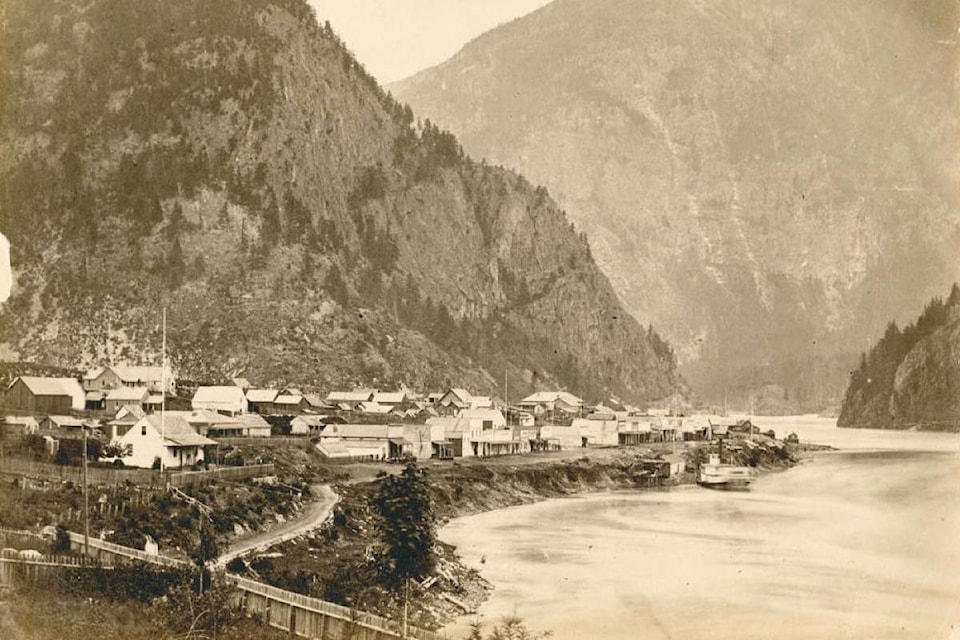In the last instalment about Yale and the surrounding area in the early days of the Gold Rush, the focus was on Hill’s Bar and the “toughs”, as journalist David Williams Higgins—who arrived in Yale in July 1858—called some of the men who were working the richest bar on the lower Fraser River.
Higgins noted that some of the Hill’s Bar men had been forced to leave San Francisco because of the efforts of the Vigilance Committee there. What Higgins does not state (but which he doubtless knew, as someone who had lived and worked in San Francisco prior to arriving in Yale) was that the Vigilance Committee was basically a group of vigilantes, taking the law into their own hands in defiance of the police and city officials and acting as judge, jury, and executioner.
It is true that the explosion in San Francisco’s population following the California Gold Rush of 1849 meant that officials were overwhelmed: in April 1848 the population of the town was 850; by 1852 it was more than 36,000. While some felt that the Vigilance Committee’s illegal actions and brutal methods were needed to keep order, others disagreed. General W.T. Sherman, who resigned from his position as Major-General of the Second Division of Militia in San Francisco, wrote in his memoirs:
“As [the vigilantes] controlled the press, they wrote their own history, and the world generally gives them the credit of having purged San Francisco of rowdies and roughs; but their success has given great stimulus to a dangerous principle, that would at any time justify the mob in seizing all the power of government; and who is to say that the Vigilance Committee may not be composed of the worst, instead of the best, elements of a community? Indeed, in San Francisco, as soon as it was demonstrated that the real power had passed from the City Hall to the committee room, the same set of bailiffs, constables, and rowdies that had infested the City Hall were found in the employment of the ‘Vigilantes’.”
Perhaps some of the men at Hill’s Bar had good reason to try to exact revenge on any of the Vigilance Committee members who came their way. Still, wherever men eager—even desperate—for riches gather in close proximity to each other, working the same strip of river for gold, trouble is bound to break out, with alcohol only making things worse (as we saw last time with Gold Commissioner Whannell—not Channell, as Higgins called him—and his drunken sabre exploits).
Some 50 years after being one of the discoverers of the riches at Hill’s Bar, miner James Moore recalled that “the first supplies most always to arrive in a new mining camp take the form of liquor.” Soon after Moore and his companions began working the bar, “the whole tribe of Yale Indians, about 300 men, women, and children, moved down the river and camped on our bar. They soon tumbled to our game of mining, and they also commenced washing for gold.”
A bootlegger named Captain Taylor arrived almost immediately after the Yale Indians did, selling rotgut whisky to them for $5 a bottle (payable in gold dust). As the natives were unaware of the true value of the gold they were trading, Taylor was able to set his own price.
The Hill’s Bar miners offered to buy out Taylor’s remaining stock after he sold enough whisky to the natives for an all-night party. Taylor—whose intent was to rob the natives after they were incapacitated—refused. The miners confiscated Taylor’s whisky and smashed the head of each barrel, then emptied the contents on the ground.
“We had christened the baby Hill’s Bar a few days before,” recalled Moore. “We now baptized the infant.”
Taylor was told to move along, which he did. Relations between the miners and the natives—probably not good to start with—grew even colder. When one of the natives refused to return a pick he had borrowed from one of the miners, the miner replied by hitting him over the head with a shovel. Both sides seized weapons, with the outnumbered miners fearing for their lives.
Before anything could happen, however, a boat came round the bend of the river. On board was Governor James Douglas, who immediately stepped in to defuse the situation, speaking with both the miners and the natives. Later he said of the event that there had been a series of provocations on both sides, and that the natives were naturally annoyed at the large quantities of gold taken from their country by the white miners.
“I also spoke with great plainness of speech to the white miners, who were nearly all foreigners, representing almost every nation in Europe,” said Douglas. He told them that no abuses would be tolerated, and that “the laws would protect the rights of the Indians, no less than those of the white man.”
Douglas’s comments about the diversity of people at Hill’s Bar is echoed by Higgins, speaking of Yale. “All was bustle and excitement in the new mining town,” he wrote. “Every race and every color and both sexes were represented in the population. There were Englishmen, Canadians, Americans, Australians, Frenchman, Germans, Spaniards, Mexicans, Chinese and Negroes—all bent on winning gold from the Fraser sands, and all hopeful of a successful season. It was a lottery in which there were few prizes. The diggings proved mostly unproductive, and at least 20,000 worshippers at the shrine of the Golden Butterfly left the river before the first snow fell.”
Those who stayed could, if they were so inclined, find amusements of various sorts in Yale, as establishments sprung up to cater to the miners (and part them from what gold they had found). We’ll hear more from Higgins about them in the next instalment.
editorial@accjournal.ca
Like us on Facebook and follow us on Twitter
